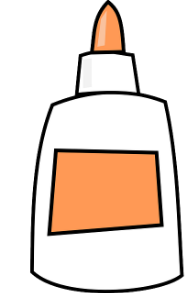How Glue Works: A Sticky Mess, Indeed!
How Glue Works: A Sticky Mess, Indeed!
A little while back, I shared the story of my first successful deer hunt. In an attempt to honor the animal, I have set out on a quest to learn how to use as much of the carcass as I possibly can. My ultimate goal is to get to the point where nothing goes to waste when I harvest animals (domestic or wild) for food. With my deer, I got all of the meat off of it that I could (including the heart and liver), took the tendons and sinew from the legs and back (more on that in a future post), and salted the hide to preserve it until I can learn how to tan it. So far, I’ve found that I will need to trim the legs, neck and a few other pieces off of it to make it look nice. To keep those pieces from going to waste, now and in the future, I have decided to learn how to make hide glue.
It seems to be a pretty straightforward process, but, as I always tend to do, I fell down the rabbit hole of how and why it works at the most fundamental level. After spending a couple of hours chasing links about the history of glue and glue innovations and adhesion and cohesion, I came to the conclusion that this would make a pretty interesting topic to post about.
.png)
A Brief History of Adhesives
Humans have been using primitive adhesives to stick stuff together since at least 4000 BC. We know this because archeologists have discovered pottery that was pieced back together using a resinous substance probably derived from tree sap. By 1500 - 1000 BC, mankind had discovered how to make a crude type of animal glue. It was used to paste together parts of paintings and murals, and the Egyptians used it to glue together caskets and other ceremonial burial items. Over the next 3,000 years or so, these animal glues would be refined, improved upon, and even industrially produced. During the 1800’s, rubber-based glues began to be introduced, but it wasn’t until the 1930’s that the first fully synthetic glues were produced. Then, in 1940’s, Harry Coover Jr. discovered the use of a class of chemicals called cyanoacrylates as adhesives. His invention would be sold commercially under several different names, but it would come to be known as Super Glue to the general public.How Glue Works
Just take one trip down the adhesives aisle at any hardware store, and you’ll realize that there are a LOT of different types of modern glue. This article will focus primarily on the more primitive types of glues and what causes them to stick and hold. I know Super Glue is cool and all, but we’ll just have to save that post for another day.
During my research, there were a few concepts that kept coming up over and over again. In order to build a solid understanding of how glue works - something that will adhere in your mind - I feel that it is appropriate to approach each of those topics individually and stick them all together at the end.
Cohesion
Cohesion is when molecules of the same kind are attracted to each other causing the substance to stick together. The easiest example of this is water. If you’ve ever seen water splashed onto a window, you probably noticed that most of it rolled down off of the glass, but there were still water droplets left behind. Cohesion is the reason why the water forms those droplet shapes (or floating spheres in space).
The cohesive force that holds water together in a droplet is caused by hydrogen bonding between individual water molecules. A water molecule is made of 2 atoms of hydrogen chemically covalently bonded to 1 atom of Oxygen. But, even though oxygen is sharing electrons with hydrogen, it is still has a stronger attraction for electrons than hydrogen - a property known as electronegativity in chemistry. And, since the oxygen atom is able to hold the shared electrons closer to itself for most of the time, it has a partial negative charge compared to the hydrogen atoms, which have a partial positive charge. Since the molecule has two oppositely charged ends, we call it a dipole.
Riccardo Rovinetti [CC BY-SA 3.0 (https://creativecommons.org/licenses/by-sa/3.0)], from Wikimedia Commons
When multiple water molecules get close to one another, these partial charges cause them to arrange themselves so that the hydrogen atoms (∂ positive) are oriented toward the oxygen atoms (∂ negative). It is these weak attractive forces known as hydrogen bonds that cause water to stick to itself. Interestingly, it is also the force that causes the two strands of our DNA to stick together in that double helix shape.
User Qwerter at Czech wikipedia: Qwerter. Transferred from cs.wikipedia to Commons by sevela.p. Translated to english by by Michal Maňas (User:snek01). Vectorized by Magasjukur2 [CC BY-SA 3.0 (https://creativecommons.org/licenses/by-sa/3.0)], via Wikimedia Commons
Hydrogen bonding, one type of Van der Waals force, is the force of attraction caused by dipoles between molecules that contain a hydrogen atom bonded to either oxygen, fluorine, or nitrogen. Another type of Van der Waals force, called dipole-dipole force, occurs when a hydrogen atom is involved in a polar bond with any atom other than oxygen, fluorine, or nitrogen. So, hydrogen bonds are sort of a subcategory of dipole-dipole forces, if you want to think about it that way; the difference being that they are stronger than other dipole-dipole forces due to the fact that O, F, and N are really, really good at attracting electrons, so they form stronger partial charges.
The third type of Van der Waals force is known as the London dispersion force. This phenomenon occurs due to the random motion of the particles that make up the atom, namely the electrons. If there ends up being more electrons in any one area around the atom/molecule, it will give that end a weak partial negative charge. This sudden but temporary dipole can create a chain reaction throughout the entire substance where the first partial negative charge causes the electrons in the next atom/molecule to be repelled, inducing another dipole and so on.
All of these forces (and probably a whole list of others) can cause the molecules of a substance to be attracted to each other, making the substance feel what we would call sticky. The stronger the intermolecular forces are, the stickier the substance will be, and this stick-together-ness is what we call cohesion.
Adhesion
Adhesion is when one substance sticks to a different substance. Let’s go back to our water on the window scenario for an easy example. If the water sticking to itself to form drops is an example of cohesion, then the water drops sticking to the glass is an example of adhesion. In our example, the molecules that make up the glass are polar, so there is an attractive force between the glass and the water.
Different glues have different methods of achieving adhesion. Some glues depend on a process called adsorption. Adsorption is the ability of a substance to form a very thin layer across the surface of another substance. In many cases, there will be weak electrostatic forces of attraction between the two substances (like the Van der Waals forces we discussed, earlier). Over a large surface area, these attractive forces add up to a decent amount of adhesion. For these types of glues, it is probably beneficial for the surfaces that you are working with to be clean but not smooth. The microscopic grooves and cracks give extra space for adsorption to occur, increasing the surface area, thereby increasing the sum of those electrostatic forces of attraction.
Other types of glues rely on a process called chemisorption. These glues undergo a chemical reaction with the surfaces that they adhere to, literally becoming a part of that substance on a molecular level. They tend to adhere very strongly to their substrate.
What Makes A Good Glue?
That all depends on the application. Some glues have a stronger adhesion than they have cohesion. If enough stress is applied, these glues will generally pull apart in the middle, leaving glue residue on both surfaces; OR, if the glues cohesion is stronger than the integrity of the bonded substrate, the glued surface may crack or break.
On the other hand, if the glue has stronger forces of cohesion than adhesion, then one glued surface should come off clean, leaving the glue residue on the other… Or, again, the substrate itself could experience catastrophic failure.
And that is where hide glue comes in. Hide glue is water soluble and can be deactivated by heat, so it is probably not the best for every application; however, there are some projects where you may want the ability to easily disassemble the piece and then put it back together, again. Luthiers who build violins like to use hide glue for this very reason. It is often necessary to take a violin apart piece by piece to make repairs. Old school animal glues can be deactivated with a little bit of heat (you probably wouldn’t want to us water; it may warp the wood.), the instrument can be serviced, and the luthier can put it back together as good as new. Now, I don’t plan on building any violins, but it is cool to know that I will be able to make a viable glue product right in my own back yard. You know; just in case the zombies ever come after me.
Resources
Bostik Adhesive Education Series
Harry Coover and the Invention of Super Glue
The Science of Stickiness Revealed
https://www.physlink.com/education/askexperts/ae206.cfm
Long time no see! Gonna see more of you?
Thanks! I got busy and bogged down there for a minute, but I'm here for the long haul!!
This post has been voted on by the SteemSTEM curation team and voting trail in collaboration with @curie.
If you appreciate the work we are doing then consider voting both projects for witness by selecting stem.witness and curie!
For additional information please join us on the SteemSTEM discord and to get to know the rest of the community!
Congratulations! Your post has been selected as a daily Steemit truffle! It is listed on rank 11 of all contributions awarded today. You can find the TOP DAILY TRUFFLE PICKS HERE.
I upvoted your contribution because to my mind your post is at least 6 SBD worth and should receive 131 votes. It's now up to the lovely Steemit community to make this come true.
I am
TrufflePig, an Artificial Intelligence Bot that helps minnows and content curators using Machine Learning. If you are curious how I select content, you can find an explanation here!Have a nice day and sincerely yours,

TrufflePig